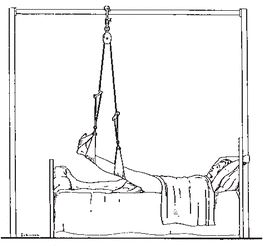Many of the earliest casualties from the First World War were large guardsmen with grievous wounds. For the short of stature like Mrs F Guthrie Smith – the masseuse in charge of a temporary command depot hospital on the British Downs – exercising these men was both a problem and a challenge.
Guthrie Smith was a yachtswoman who knew that a rope and pulley could be an effective way to move a heavy load. To her delight, she found that the injured men did not mind pushing themselves to increase their joint range and improve muscle strength when they used the rope and pulley system she had made.
 Shortly after the war, a paralysed patient was having pulley exercises for his arms and Guthrie Smith slipped the ropes on to one paralysed leg so that it was held off the bed by two ropes of the reciprocal pulley. As she had perhaps anticipated, the paralysed limb showed some voluntary movement, and Guthrie Smith realised that with the force of gravity removed the severely weakened muscles could be persuaded to contract and movement could be demonstrated.
Shortly after the war, a paralysed patient was having pulley exercises for his arms and Guthrie Smith slipped the ropes on to one paralysed leg so that it was held off the bed by two ropes of the reciprocal pulley. As she had perhaps anticipated, the paralysed limb showed some voluntary movement, and Guthrie Smith realised that with the force of gravity removed the severely weakened muscles could be persuaded to contract and movement could be demonstrated.
The systematic knowledge that came to be known as Guthrie Smith Suspension Therapy was developed over subsequent years, and Guthrie Smith was awarded the Order of the British Empire (OBE) in recognition of her pioneering rehabilitation work.
Links
Guthrie Smith frames today.
How radical is robotic physiotherapy anyway? (Link)
There are no new treatments in physiotherapy (Link)
Reference
Hollis M. 1994. Slings and Springs: How did they start? Physiotherapy, 80 (1), 84A.


Excelente texto. Estou compartilhando nas redes sociais